Text
Protest South Korean Embassy in DC for dog and cat slaughter August 7
"According to IDA, 2.5 million dogs and thousands of cats are cruelly killed each year in South Korea for human consumption. Dogs are electrocuted, hanged and beaten to death. Cats are bludgeoned and boiled alive in water." http://www.examiner.com/article/south-korea-dog-cat-meat-industry-to-face-protests
#washington dc#south korea#animal cruelty#ida#animals#dog#dogs#cat#cats#dc protest#south korean embassy#protest#protest animal cruelty
2 notes
·
View notes
Link
Learning dogs body language is an important aspect of living with your dog! Your dog learns your habits and words, why not extend the favor? :)
0 notes
Quote
The greatness of a nation and its moral progress can be judged by the way its animals are treated.
Mahatma Gandhi
17 notes
·
View notes
Note
hey :) i just read your post about fearful dogs and one of my dogs has most of those characteristics! we've had him for five years now and he still acts like that, especially when my mum comes home from work, he waits at the door for her for ages, then when she comes he runs away looking scared, even though she's always nice to him. he's not aggressive at all though, so i don't understand why he's like that :S he's a rescue dog so he may have had a traumatic experience before we got him
Aw, well dogs can be pretty complex creatures especially rescues. I wouldn't really worry about yours unless she shows signs of being in distress like pacing, drooling, leaning / cowering, panting, shaking. She may just be showing signs of submission, as long as she is still happy that's a good thing!
0 notes
Text
Fearful and Fear Aggressive Dogs
I am inspired to write this post entirely from personal experience with my own fearful 9 month old puppy. I would like to share some tips with others who may be (like I was) a little in the dark about what to do.
I have two rescue dogs, both sisters from the same litter though with different dog "dads". They couldn't be more different in personality! Dora is the happy-go-lucky pup who is always down for a belly rub from a stranger. Tokio is extremely cautious and fearful from within 10 feet of our own front door until we are in a quiet calm neighborhood or park with no strangers or strange vehicles to startle her.

Fearfulness in dogs can occur from lack of socialization or a specific traumatic event in their early puppyhood when their ideas about the world are first in formation, and some dogs are genetically predisposed to being "skittish". Still others have been abused or are feeling pain. Another common cause is learned fear (i.e. through positive reinforcement, the owner inadvertently affirms the dogs fearful behavior by coddling it and giving it lots of positive attention/praise - the dog then begins to think that's how the owner wants it to behave) With many dogs it is a combination of a few if not all of these factors.
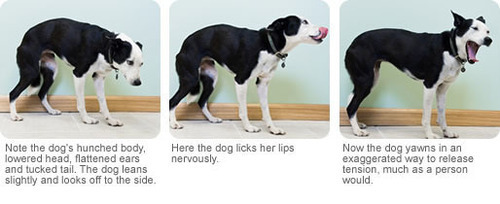
It is important for owners of fearful dogs to consider why the dog is fearful. Personally I know that Tokio is not fearful from a lack of socialization, learned fear, or pain. I adopted both her and her sister at 8 weeks, and they were raised the same way in the same environment yet as I said before are very different! I also know that it is not from pain because she has been to the vet within the last month, and shows no signs of discomfort. Looking back in her past however, I can remember a time when a family member took her out for a little walk at around 12 weeks. There was a neighbor outside and Tokio dashed out across the street to say hi before the handler could catch the leash. It just so happened that there was a car coming up the street. The handler naturally ran out to catch Tokio and was very distressed, yelling to "Watch Out!" and probably feeling very hysterical. Tokio was then quickly scooped up in a panic and taken inside. This episode may very well explain her extreme fearfulness of trucks and fast moving cars. Her fearfulness is probably also genetic, as she is naturally more wary of strangers and jumps at loud noises.

Knowing the root of your dogs fears can help you take the necessary steps and time to correct the behavior that perpetuates fear. Essentially your dog needs to associate the thing that makes him or her irrationally afraid with POSITIVE experiences rather than NEGATIVE experiences. As you probably already know from dealing with a fearful dog, it's just not that easy! The following tips are NOT meant to supplement professional dog training. Dealing with a fearful dog can be dangerous depending on the level of fear and lack of resources. If you ever feel that you need professional help, please contact a local dog behaviorist / trainer that has worked with fearful dogs before. Fearfulness in dogs can lead to fear-biting and other forms of aggression, the effects of which can be long-lasting if not handled properly.
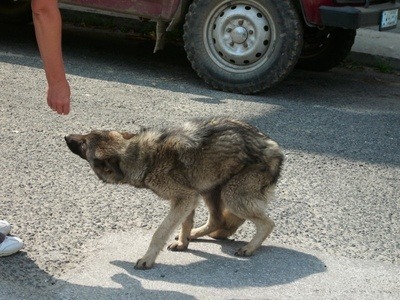
The first step to understanding and working with fearfulness in your dog is to be able to recognize a.) Signs of Fear in dogs b.) Warning signals .
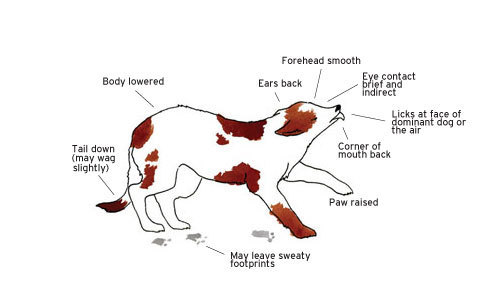
The second step is to identify what exactly makes your dog afraid. If your dog reacts fearfully to strangers, ask yourself: Is it all strangers? Specifically tall / short ones? Children? People with walkers? Is it gender specific?
Learning the specific trigger will help you be able to predict and treat the behavior before it escalates. If you know that you will encounter these types of strangers on your walk or elsewhere you can be prepared.
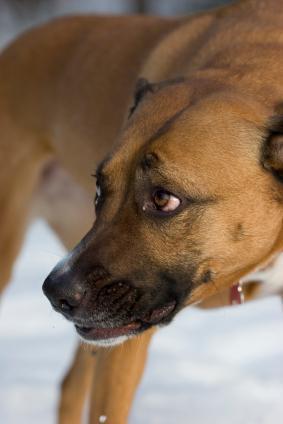
Third, you will need to learn your dogs threshold. At what point during the experience does your dog actually show signs of fear? If your dog is afraid of thunder, does the fear behavior take place when rain can be heard? Wind? Some dogs feel comfortable in their homes or in a particular safe room or place. If you know the invisible boundaries of what your dog considers safe vs. what your dog considers scary, you can pace the learning experience to ease your dog into a relaxed state.
So now that you know exactly what your dog is scared of and when, you can begin creating a positive atmosphere when the "scariness" occurs.
So what to do?

Hire a professional POSITIVE-Training dog trainer. There are different methods of dog training, some include the addition of punishment - like using noisemakers / squirt guns to dissuade your dog from continuing behavior. The last thing you want to do with your fearful dog is introduce punishment when the scary thing is around. This includes shock collars for barking! (Barking at strange noises outside can be a natural reaction from a fearful dog)
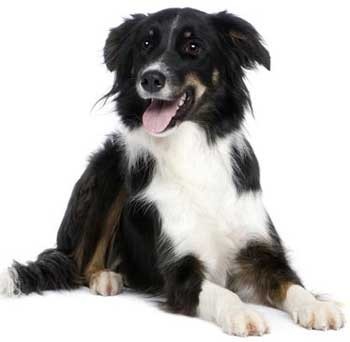
In the meantime, or for emergencies:
Purchase all-natural calming treats like Pet Naturals Calming or Bach Flower Remedies these are non-chemical, natural mild sedative treats.
Use lavender oil / spray
If you feel confident and capable of committing to the time and care it takes to train your own dog, please do research on modern positive techniques. Here is a great article that gives a step-by-step training guide for managing fear & fear aggression. This is a very standard practice for most positive dog trainers. Please make sure that if you do begin training your own dog that you are dedicated to regular daily & weekly practices. If you do not have the time or the resources to follow through with training effectively, you can hire a dog trainer for a more structured environment. Reading the above article will help you understand how your dog will learn regardless of whether you intend to train without a professional.

It can be a long process to rewire a dogs emotional response, as with most animals and humans! I am still in the process of training. We have made leaps and bounds from a month ago where my dog wouldn't even come out of the front door let alone down our steps. We began to treat her immensely literally each step of the way at first. We then gradually (short sessions!) increased the distance for her to get a treat. Every few days she had a new threshold. Now she comes and goes out the front door of our building but will often bark and try to bolt if people are nearby. Now what we will be practicing with her is staying at the threshold (which is actually the threshold of the building entrance, ironically) sitting down in that spot for 5 minutes, getting treats and then we go back inside or out the back entrance where she is most comfortable. Sometimes we sit out on the steps with her and she gets to meet the neighbors who are all very nice to her. It takes more than a few practices, it is a daily routine. It's sometimes hard to keep up with, but it is entirely worth it.

I wish you all success and don't forget, if you ever need professional help do not hesitate to get it! A fearful dog is not only agonizing for the dog and the human, it could be or become dangerous as fearful dogs are known to lash out and fear-bite.
Some more resources:
http://fearfuldogs.com/
http://www.aspcabehavior.org/articles/50/Canine-Body-Language.aspx
#dogs#dog#fearful dog#fear aggressive dog#fear#fear aggression#animals#animal#puppy#puppy biting#puppy training#puppies#dog training#dog behavior#pet naturals#bach flower remedies#positive training#positive reinforcement
4 notes
·
View notes
Text
Aromatherapy for your Dog?

Dogs first and most acute sense is, of course, smell. It was recommended to me recently that I try using pure lavender oil to help my nervous dog. I did some research and thought I would share in case any one else has a fearful / nervous / hyper / anxious dog... upon learning more about how lavender can help soothe and calm animals (including humans!) nerves, I also came across a few other great uses for lavender oil and your pet.

If you would like to begin using essential lavender oil as aromatherapy, please be sure to only purchase completely pure lavender oil, with no other preservatives / chemicals. It should have a label with information, or is a brand you feel comfortable with. Next, be sure to dilute the essential oil with water. You can put a few drops into a spray bottle with water. The amount of oil per water depends mostly on the size of your dog. You should consult your vet for an appropriate amount. I just put a few drops into a 10 oz spray bottle, until I felt the smell was not overpowering for my 14 lb dogs.

Besides calming your pup, lavender oil can also be used to help house train by smell association.
Here are some applications:
Spray your entire house with the pure diluted lavender oil mixture.
Give your dog a sponge bath with a few drops of lavender oil. (Now your dog smells like the house! Make sure to spray his/her favorite potty spots if you want to help house train your dog.)
Spray your car with the lavender oil mixture.
You can topically apply a small amount to the chest and neck of your pup.
Spray the mixture onto bedding to help induce a more peaceful sleep
You can also spray this mixture before you leave in order to help with separation anxiety.
And you can help keep bugs and parasites away from your dog (lavender is a natural mosquito repellent)

As always, be mindful of the effect it has on your pet. You should use a small amount at first. Do not give your dog lavender oil internally.
#dog aromatherapy#pet aromatherapy#aromatherapy#dogs#dog#puppy#puppies#hyper dog#hyper puppy#anxious dog#anxious puppy#separation anxiety#fearful dog#fearful puppy#dog training#dog obedience#puppy training
1 note
·
View note
Text
Bedlington Terrier - Breed of the Month
Personally I am not a Purebred kind of person, I love my mutts and only rescue dogs. However, I think that it's a great thing to understand different dog breeds - and it also helps to identify what breeds are mixed with.
So we'll start with this month's Breed... the Bedlington Terrier.

Originating in England, bred to hunt vermin and was also used for racing as indicated by its sleek body line.

Mild and gentle temperament, the Bedlington Terrier can also be energetic and courageous. They are known to have the looks of a lamb with the heart of a lion.
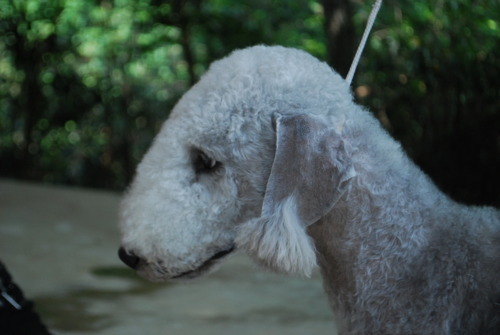
Bedlington Terriers require experienced groomers to keep their looks in shape.

As with all dogs, the Bedlington Terrier needs daily exercise including walks. Because it is still a terrier breed it is going to be high-energy, so allowing it to utilize its hunting instincts will be best to avoid boredom which can lead to anxiety and destruction. It is recommended that these dogs be enrolled in Agility Training, Earthdog events, or other sorts of aerobic / problem solving activities. This dog is suitable for an apartment if you can take the time out of your daily schedule to spend a few hours each day (at least) giving it proper exercise!
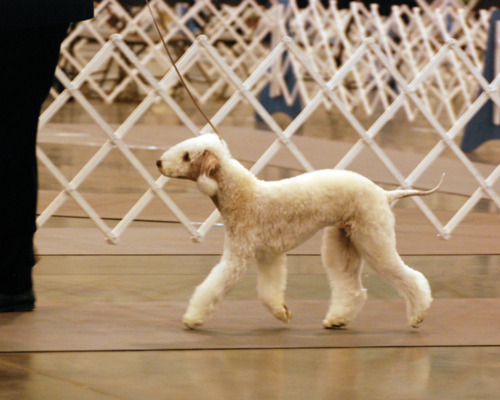
The average lifespan of a Bedlington Terrier is 13.5 years.
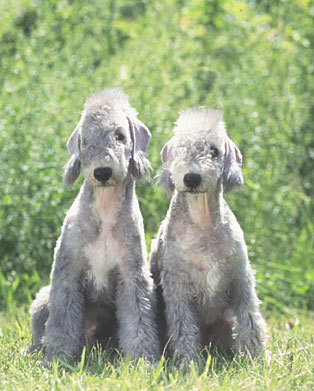
A common health issue with Bedlington Terriers is Copper Toxicosis. It is essential that anyone interested in purchasing a Bedlington is provided with proof of the dogs' unaffected status. All reputable breeders will be able to provide you with proof of DNA or biopsy testing of the parents.


Do you have any experience with Bedlington Terriers?
4 notes
·
View notes
Text
DIY: Dog Training

You can get your dog to perform any behavior (within her natural range of abilities of course) on command. You don't have to just stick with the "sit" "stay" "down" and leave it at that! Some examples of funky dog tricks are: Put a toy away, Fetch the car keys, Ring a Bell, Fetch a Beer, Dance, etc.
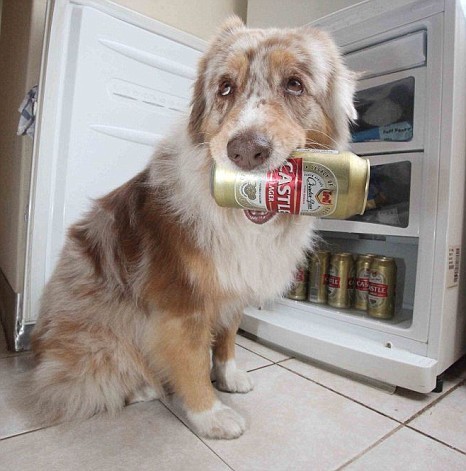
Once you are familiar with Positive Reinforcement you can begin to implement this formula to help you teach your dog unique tricks.
1. Get your dog to do the behavior. (This can be through Shaping, Luring, or Physical Correction. Also, for tricks like "Speak" sometimes you just have to wait for your dog to do it!)
2. Name the behavior (you cannot name the behavior before the dog has done it. This is to prevent confusion, and also so that you don't get in the habit or get your dog in the habit of repetition. You want to say the command once and be obeyed that one and only time.)
3. Reward the Behavior
4. Physically correct (not punishment, simple body adjustments) if the behavior is not accurate.
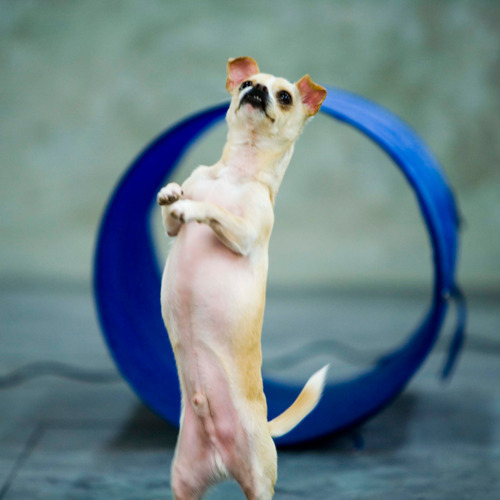
So what is Shaping?
Shaping is when you begin to teach your dog a new behavior in increments by rewarding partial behavior. Let's say you want your dog to lie down in the middle of the mat. Well, he lies down somewhat on the mat but he's not in the center yet. Once he lies down somewhat on the mat, use the Conditioned Reinforcer (CR) - such as a clicker to mark the behavior and give him a reward. Next time raise the criteria, until he adjusts himself accordingly to get the treat.
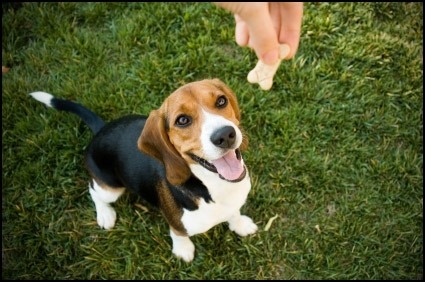
And Luring?
Luring is simply when you lead a dog by its nose to do what you want it to do. A classic example is getting a new puppy out the door on the first day for a walk or a romp in the yard. Another example is when teaching tricks like lie down, roll over, or jump up. The treat is made sniffable, and then guides the dog in the direction you want him to go.

Physical Correction?
This is not a punishment, this is when you simply adjust the behavior to be appropriate. If you tell your dog to sit, and she just looks at you, rather than repeating yourself, simply gently but firmly press her backside to remind her of what you asked. Another example is if you tell her "OFF" (to get off of a couch or bed) you will have to go to her physically and remove her from the couch if she doesn't obey the first time, or simply doesn't understand. For tricks like shake this is also helpful.

You will probably have to use a combination of all 3 sometimes.
If you use a CR like a clicker, that's great. Just remember timing is everything. Don't mark the wrong behavior such as pawing or jumping for a treat or your dog will think that is part of the desired behavior.
It's also helpful to associate hand signals with commands in case you aren't able to verbalise them.
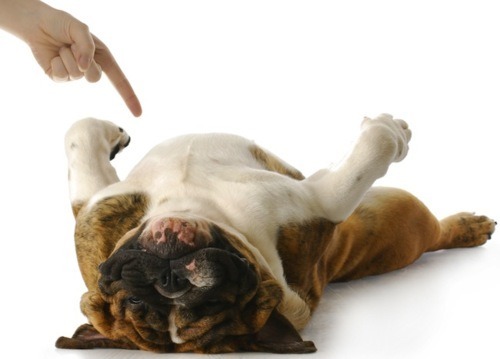
2 notes
·
View notes
Text
Sit-Stay Command + More!
This video is a great instructional video on some basics of training, containing a lot of helpful tips on how to get your dog to sit and stay and principles of training utilizing Positive Reinforcement rather than Punishing Your Dog.
Hope you find it useful!
0 notes
Text
5 Minute Cooldown
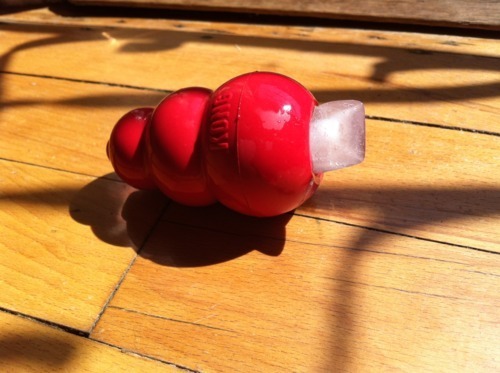
After playing outside and walking all morning, my two puppies really enjoyed this Rubber Chew Toy Stuffed with an Ice Cube!
Ice cubes are a fun treat (just make sure it is not big enough to get lodged in the throat.) I don't have an ice-pick and my dogs are small so I stuffed a kong toy with an ice cube.
It's a great no-calorie treat that will keep your pup occupied for a good 5 minutes, not to mention a great treat on a hot day, or for teething / mouthy puppies.
0 notes
Photo


HAPPY NATIONAL PUPPY DAY 2012
♥
Dora the Explora' & Tokio Black
8 notes
·
View notes
Text
Positive Reinforcement

We are all more or less familiar with the terms "Positive Reinforcement" - however, did you know that it is the most influential aspect of Operant Conditioning ( this is what we knowingly/unknowingly use to teach dogs appropriate behaviors. Essentially it is a form of learning in which an individual modifies the form and occurence of his or her own behavior due to the consequences of his or her behavior. )
Whether you know the terminology or not, whenever you train your dog to do something you are using Operant Conditioning, and if you are rewarding good behavior you are using Positive Reinforcement.

The key behaviorist to develop the system of Operant Conditioning is a man named B.F. Skinner. According to Skinner, Positive Reinforcement is superior to forms of punishment to alter behavior.
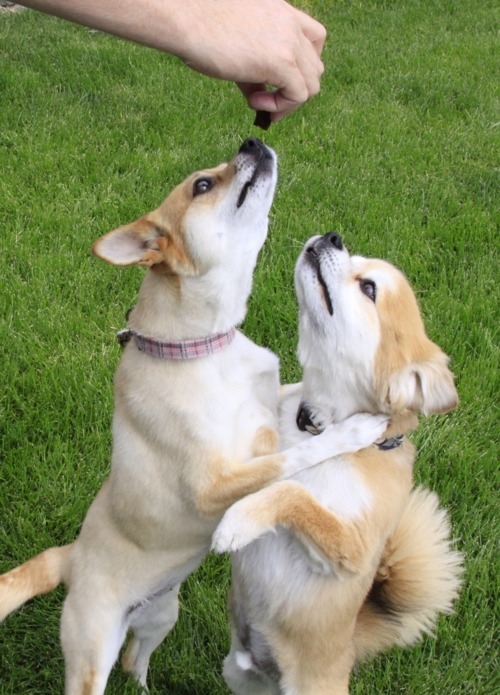
What IS a Positive Reinforcer?
Practically anything your dog likes and will work at to get is already a Primary Reinforcer.
A lot of trainers use a Conditioned Reinforcer - something that your dog has learned to like because of its association with the Primary Reinforcer. Conditioned Reinforcers are used in training purposes to mark a specific behavior for Primary Reinforcement, it lets your dog know that she did something right AND will be rewarded for it.
Common Conditioned Reinforcers are: Clickers, Specific words like 'YES!' or 'BINGO!'

Ex. You tell your dog to sit. Your dog sits. CLICK <- Conditioned Reinforcer. Reward <- Primary Reinforcer.
In practical terms, a Conditioned Reinforcer allows you to communicate with the dog that out of all the possible things he was doing, the point at which you clicked signified the behavior you want and (very important) that a treat will follow to Reinforce that behavior.

Conditioned Reinforcers work so well for two reasons:
1. It signifies to your dog what he did right. He associates the click with a reward so he will be more likely to repeat the behavior just because of the click.
2. It allows you time to get a reward for him. If you are just using a primary reinforcer, you can't mark what behavior got him the reward, especially if you are trying to teach him very specific commands like to go and lay down in his bed when someone comes to the door, there are a number of behaviors that he can do in the time it takes for you to get the treat and even when you give the treat he could stop doing the behavior (i.e. you tell him to lay down, he lays down, you approach him with the treat and he sits up, you feed the treat and actually only reinforce sitting up)

It is very important that you charge the Conditioned Reinforcer (CR). The only way it will work is if you make the connection in your dogs mind that the CLICK means TREAT. You can charge the CR before your training session by using the CR and treating the dog each time he hears the CLICK. This way he'll know that the CLICK is the precursor to reward. It's like getting your paycheck, the piece of paper is useless at the moment but you are happy knowing that once you deposit it you'll have money.
It's also very important that each time the CR is used, that your dog gets a reward!
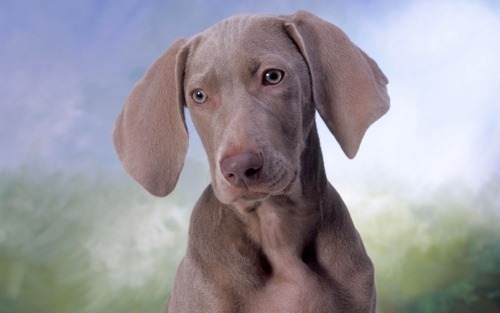
Since you don't want to stuff your dog full of treats in one day, be sure to use repetition but also to mix it up - expect more of your dog each time your dog does something right. If part of your training requires your dog to sit, but your dog already knows how to sit, you don't need to reward her for sitting, only for accomplishing the behavior that you request. For example, The "Sit-Stay" command means your dog should get a reward after "staying", not just for sitting (Unless it is the first time you are using the command.)
#dog#dogs#dog training#operant conditioning#puppy#puppies#puppy training#dog care#puppy care#positive reinforcement
2 notes
·
View notes
Text
Puppy Supply Checklist

So you're getting a puppy, Congratulations! Getting a dog and starting "from scratch" will save you a lot of headaches later on in life. However, for the record, puppies are a LOT of work, a full-time job actually! There is no way to really stress to any first-time dog owner how much work will have to be done with a puppy in order to condition it to be the perfect dog - however, as long as you're willing to make the commitment and not give up, everything will be OK!

Before you get your puppy make sure to get as many items as you can so that you don't have to run off to the store, or bring your puppy into the store with you. It's okay to take dogs with you into pet stores, but for a young puppy, all the sights sounds and smells can be very overwhelming, especially the presence of other (much bigger dogs)

Also, be sure to "Puppy-Proof" your home. This means that you should clean the floors spotless in each room your puppy will be allowed to play, remove anything that can fall on your puppy from counters, tables, or chairs. Also be sure to remove anything your puppy can climb onto to get to counters or tables.

Here is what you will need:
1.) A few days off from work immediately after taking your puppy home. You want your puppy to acclimate to your environment well, and to be introduced to your home.
2.) Baby gates to section off areas of your home you don't want the puppy to get to.
3.) A Crate - A wire mesh one is great for in home use. It will allow your puppy to see you and still feel part of the family while in his crate. A plastic one is great for traveling and overnight stays.
4.) A Fence, or at least a plan on how to contain your dog outside in the yard.
5.) Food - If you know what your puppy is eating now, buy some of that as well as a brand that you want to start feeding her on. You will have to mix the foods and gradually acclimate her to the new food over a period of at least 10 days. Otherwise she will probably get diarrhea.
6.) Toys - Time and experience will teach you what kind of toys to get your dog, but start with a wide variety (rope toys, squeakers, rubber chews, plastic chews, smart toys, plushies, balls)
7.) Chewing Items - Again, experiment with a few different types! Some of my favorites are bully sticks and Flossies. For stronger chewing later on try naturally shed deer antler.
8.) Soft and hard treats for training.
9.) An appointment with a vet within a few days of bringing your puppy home.
10.) Register your puppy for puppy kindergarten. You will need to learn the best techniques for training your puppy to be obedient and responsive, it will also help establish your alpha role and also it will give your dog a great chance to socialize with other dogs in a supervised environment. Socialization during the puppy months are critical!!
11.) Cleaning supplies - odor and stain remover for cleaning areas of your house your dog has used as a potty. If you remove the smell the dog will not use the same spot again.
12.) Training Pads - these are pads that you can set down to train your dog to go to when she has to relieve herself. This is a plan B for you, you will still have to house train but in the meantime, your puppy will not likely be able to hold it for very long and until you figure out exactly how long is too long, you'll want some designated areas to go potty on. Also, it helps to reinforce the command "Go Potty"

Have Fun!!
♥♥
M
31 notes
·
View notes
Text
How To Get Your Dog To Stop Barking At The Doorbell!
We all want the well-behaved dog. This video is a thorough and amazing tutorial on how to train your dog to stop barking and go to his place.
Why should you be ashamed or afraid of having visitors come to your house? Show off your puppy parenting / training skills & teach your dog this awesome trick! ;)
#dog#dogs#dog training#puppy#puppies#puppy training#puppy care#dog care#bad dogs#dog barking#puppy barking#dogs and doorbells#pug#dog training videos
1 note
·
View note
Text
A Wonderful Video On: How To Get Your Puppy To Stop Biting!
0 notes
Text
Not So Tough After All...

The Kyjen "Tough Turtle" along with their "Hide-A-Squirrel" and "Egg Baby" series are all marketed to be "tough toys" with statements like
"Dogs learn to remove hidden squeaker eggs without destroying the toy!" - Kygen on the Egg Babies
and "Durable design and craftsmanship ensures long-lasting puzzle-solving fun!" - Kyjen on the Tough Turtle
But can it really be true?
It's not just Kyjen!
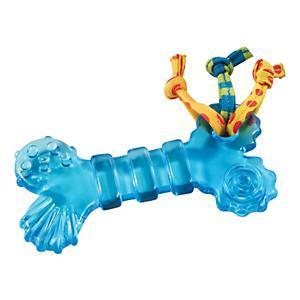
"Designed for dogs that love to chew" and "Solid construction for added durability. " - Orka on the Petstages Bone Chew
But are they really so tough and durable? Well, suffice it to say that my chihuahua/feist mix puppies destroyed them at approximately 3.5 months of age within half an hour. (So, definitely not that durable.)
**Note: Puppies begin growing their adult teeth at approximately 4 months - 5 months of age. During this time puppy chew toys which previously may have been acceptable like the Nylabone Puppy Teether will become innapropriate. When observing packaging make sure that you determine what age and chew strength is appropriate!

Some things to consider when choosing toys:
Do research on the brand. Companies like Planet Dog, Kong, Nylabone, and the eco-friendly West Paw Design for example give a thorough description of all of their toys. These descriptions are likely not to be found on the actual packaging so avoid impulse buys unless you're willing to take a chance!
Take note of what kind of toys your dog tends to destroy, are they plushies? Rope toys? Squeakers? Chew bones? When choosing another toy, consider the faults of the last one and avoid similar construction, fabric, and most importantly craftsmanship.
Do your own inspection. If a toy has "hair" try tugging on it. If it comes out easily, be sure your dog will be swallowing massive quantities of it at once! If a toy is very flexible try to stretch it. If it stretches easily your dog may be able to tear chunks of it off. Look at the seams, is stuffing or string already coming out? Your dog may be able to tear it open if the stitching isn't sturdy to begin with. Look at appendages, is anything sticking out made of felt? You will probably have to cut these bits off as your dog will definitely chew through it during a chew session.
What toys seem to be the safest / most long-lasting? I will give my Top 10 Durability Ratings based on length of time toy tends to survive in households with strong chewers! This is from my own experience as well as testimonials from others with larger breeds and aggressive chewers.
High Durability - Most people with large dogs and aggressive chewers were satisfied with the length of time the toys lasted (at least 3 months on average). Still fun enough for small dogs to gnaw on!
Moderate Durability - Most people with small-medium sized dogs were satisfied, many people with large / strong chewers were satisfied. These are usually toys that are a little more "chewable" so aggressive chewers may not be as satisfied with the life of the product.
1.) Toys from West Paw Design (High durability made with zogoflex, eco-friendly, comes with a garuantee and less than 1% returns.)

2.) Tire Tugs made from hard rubber. (High Durability.)
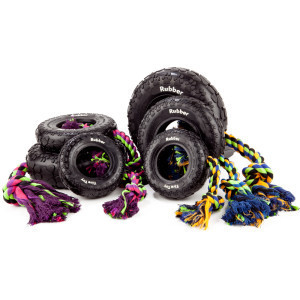
3.) Planet Dog Orbee Bouncy Ball (High Durability) :

4.) Jolly Pet Products comes with a guarantee! (High Durability):

5.) Nylabone Dura-Chew Series (Highly Durable) - but very heavy and hard, some dogs may not be interested in such hard plastic toys, this dinosaur is one of the most likable:

6.) Black Kong Toys (Highly Durable for most large breed dogs) The Red Kongs may be more suitable for a small breed dog or a medium breed depending on chew strength:

7.) Tuffie's Dog Toys (Moderate - Highly Durable, made with luggage material coated in plastic, another layer of luggage material on top of that and a soft layer of fleece. Seems the binding is the weakest link):
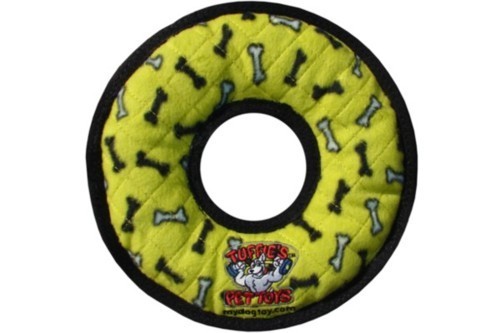
8.) Thick Rope Toys with knots and in particular monkey-paw style knots (Moderate/Highly durable depending on the quality of the rope as well as the strength of the chewer)

9.) Solid Basic Thick and Well Made Plushies (like the Kyjen Invincible Snake) or the Huggables Knottie Toys made from Corduroy (Moderate / High durability for small / medium sized dogs or larger dogs with less aggressive chew habits):

10.) The Jumbo Kyjen Hedgehog (Moderate / High durability due to it's shape and size, for dogs with aggressive chewing habits, it like most plushies may possibly be destroyed despite the design! However, my small dogs love it and can't wrap their jaws around it.):

As with all toys, you must supervise your dogs play to make sure that the toys are not being ingested. Always examine the toys during and after play, if it becomes destroyed with pieces hanging off (or missing!) Remove immediately, as an ingestion of toy parts could cause medical problems including choking or blockages.
No toys are meant to last forever, however the toys selected on this list have the durability to last longer than most! (Of course, there are always exceptions, so please be mindful of your dogs chewing habits!)
A great alternative to letting your dog destroy toys is to only bring certain toys out during certain play (i.e. Rope Toys for Tug Sessions, Balls for Ball Toss)

If your dog wants a chew session perhaps a toy is not the right choice for him or her. You could always supplement the urge to chew with an edible chew such as
- Antlers (naturally shed, do not shatter or splinter, available in most pet stores):

-Bully Sticks:

- and Flossies (my puppie's favorites!):

#dog#dog toys#dog toy reviews#dog care#dogs#puppy#puppies#puppy care#puppy dog toys#puppy dog toy reviews#kyjen#kong#west paw design#planet dog orbee#planet dog#nylabone#tough dog toys
2 notes
·
View notes
Text
Puppy Nutrition: The Basics
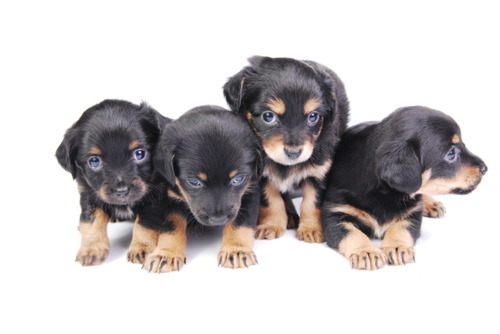
Growing dogs exhibit omnivorous feeding behavior and therefore their diet should be comprised of proteins, carbohydrates, fats, vitamins, minerals and water in the correct proportions.
The amount of food a puppy requires changes during growth and depends on the puppy’s age, breed, gender, activity, temperament, environment and metabolism.
Until puppies are full grown (12 to 18 months), their organic puppy food should contain extra protein, calories and nutrients. And as a general rule, puppies eat about two times more per pound of body weight than adult dogs, which drops gradually as they age.
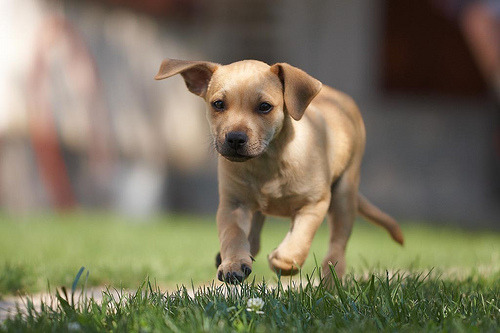
Proteins:
Foods that use human-grade meat that has been certified by organizations like FDA, USDA and Oregon Tilth.
Avoid foods that contain Animal By-Product. Animal by-products commonly found in commercial dog food can include feathers, hair, leather, gristle and fecal waste. Mmmmmm…fecal waste.
Meat and bone meal (usually made of ground bone, gristle and tendons) is the cheapest and least nutritious of all the by-product meals. In addition to being unhealthy in many other ways such as leading to canine tumors, about 25% of the protein in meat meal cannot be used by dogs' bodies.

Fats:
Fats are used to supply energy, essential fatty acids, and transport the fat-soluble Vitamins A, D, E and K. In addition, fats make a diet more palatable to a puppy. Fats help to maintain a healthy skin and haircoat. However, if a puppy’s fat intake is very high, it may result in the puppy eating excessive amount of energy that may predispose to growth spurts, rapid growth, developmental orthopedic diseases, weight gain and obesity.
Commercial dog food contains chemical preservatives to keep fat from getting rancid.
Chemical preservatives can have many harmful effects, including:
Allergic reactions to dog food
Behavioral problems
Chronic dog diarrhea
Dehydration
Dog diabetes from stress on the adrenals and pancreas
Dry, itching dog skin
Excessive thirst
Fetal abnormalities
Hair loss
Inhibit the growth of useful intestinal bacteria
Liver damage
Metabolic stress
Dog obesity from additional calories with no nutritional value
Reduce the absorption of "good" parts of food
Serum cholesterol increase
Dog teeth and gum problems

Carbohydrates:
Carbohydrates provide energy and are made up primarily of sugars, starches and cellulose (fiber). Carbohydrates are supplied in the diet from plant sources such as grains and vegetables. The sugars are 100 percent digestible. Starches, which are the largest part of most plant carbohydrates, need to be cooked before they can be digested and utilized by the puppy. Cellulose is not digestible, but it is used for its fiber content in the diet which helps to maintain gastrointestinal health.
Carbohydrates can have a lot of great nutrients if they are high quality.
"Filler" carbs, on the other hand, such as sugar and corn syrup (commonly found in commercial dog food) lead to dog obesity. They fill your dog up with unhealthy food that takes the place of nutrient-rich wholesome food. In contrast, good organic dog food uses vitamin and nutrient-rich sources of carbohydrates.
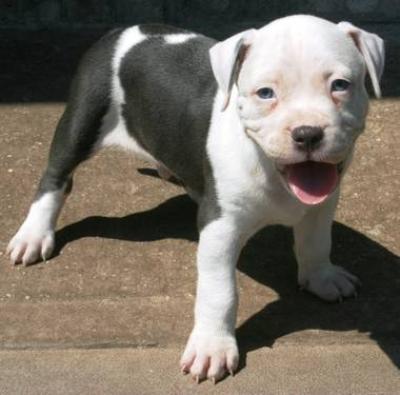
Avoid food with food coloring. Your puppy doesn't care about the color of the food, it only cares about the way it smells and tastes! The food coloring is there to make the dog food look good to YOU. The effects of artificial coloring have not been fully tested, but they are believed to increase sensitivity to viruses and could potentially cause cancer.

Getting Organic Puppy food will be the best choice to make sure that you are meeting your dogs nutritional needs. Look for certifications by agencies like AAFCO, USDA, Oregon Tilth, and CVM. Look at the ingredient list, it will be ordered by the most prevalent ingredient to the least. Look for foods that have meat first.

Some Other Tips:
-It's also recommended that you feed your dog a Grain Free diet, as celiac disease is common in canines (Gluten intolerance)
-Never abruptly switch food, slowly incorporate it over the course of a week.
-Use dry food as much as possible.
-Generally feed a puppy under 4 months 3 times a day, and a 4+ month old 2 times a day.
-Organic Treats should only make up 10% of your puppies caloric intake.
♥♥
M
#Puppy#puppy training#puppy care#puppy diet#dog#dogs#puppies#dog care#dog diet#dog nutrition#dog care#dog training#bue nose pit bull#pit bull puppies#irish wolf hound#chihuahua mix#chihuahua puppy#basenji puppy#yellow lab puppy#mutt puppies#dog food
0 notes